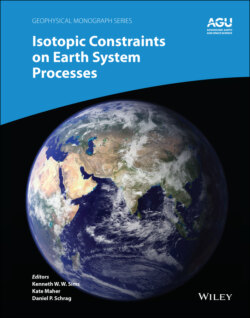Читать книгу Isotopic Constraints on Earth System Processes - Группа авторов - Страница 41
1.6.4. Evidence of Evaporation in Natural CAIs from Chondritic Meteorites
ОглавлениеThe correlated isotopic fractionation of magnesium and silicon in CAIs led to the suggestion that their precursors were melted by a transient heating event during which their more volatile components, MgO and SiO2, were partially lost by evaporation (see discussion in Grossman et al., 2000; Richter et al. 2002). The best evidence for this comes from comparing the correlation between the magnesium and silicon isotopic fractionation of laboratory evaporation residues with that of actual CAIs (see Fig. 1.18). The δ29Si versus δ25Mg data from the natural CAIs are somewhat scattered but there is a definite trend of larger silicon isotope fractionation being associated with larger magnesium isotope fractionation. The scatter can, for the most part, be explained by the precursor of each CAI having a somewhat different Mg/Si composition. The more silicon‐rich the precursor the faster silicon evaporates initially compared to magnesium and as a result the δ29Si versus δ25Mg trajectory will be somewhat more δ29Si‐rich than for the evaporation residue of a less silicon‐rich precursor. The same applies to the magnesium isotopic fractionation of precursors with more or less MgO compared to SiO2. Overall the comparison of the isotopic fractionation of silicon versus magnesium of evaporation residues from experiments with the trend of the natural CAI fractionations is persuasive evidence that many CAIs did indeed evaporate some fraction of their initial silicon and magnesium. Once one is persuaded that CAIs with correlate silicon and magnesium isotopic fractionation are evaporation residues, their isotopic fractionation, together with experimental values for α Mg and α Si in the Rayleigh fractionation equation, can be used calculate the fraction of silicon and magnesium that evaporated. Knight et al. (2009) used this approach to estimate of how much MgO and SiO2 had evaporated from particular CAIs to calculate the bulk composition of their precursors and make a more detailed comparison with the predictions of the bulk composition of condensates from a solar composition gas. Richter et al. (2006a) gives several examples of how the experimentally determined evaporation kinetics and associated isotopic evolution of evaporation residues can be used to calculate detailed trajectories of CAIs in time‐temperature‐bulk composition space. These trajectories show that the precursors of CAIs were reheated and partially molten for at most a few hours. A nebular shockwave was a plausible process responsible for the short‐duration heating event (see Fig. 9 in Richter et al., 2006a)
Figure 1.18 This figure compares the correlation of the silicon and magnesium isotopic fractionation of vacuum evaporation residues using data from Richter et al. (2007) and Knight et al. (2009) with isotope fractionation data from natural CAIs listed in Table 2 of Clayton et al. (1988).
